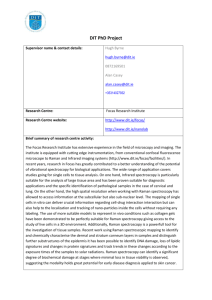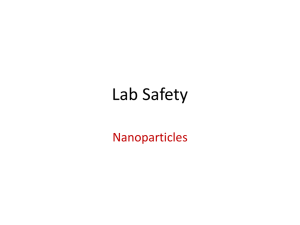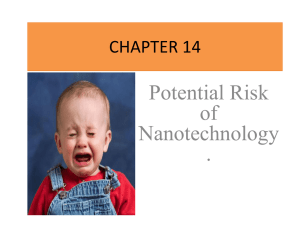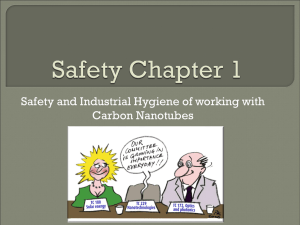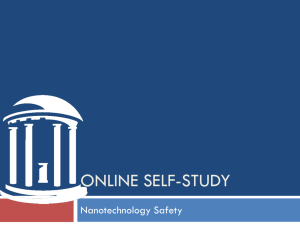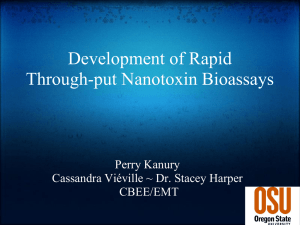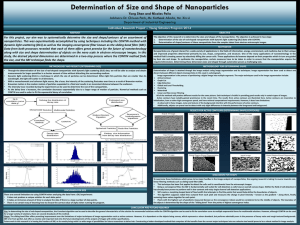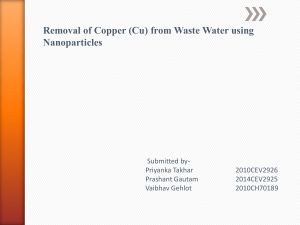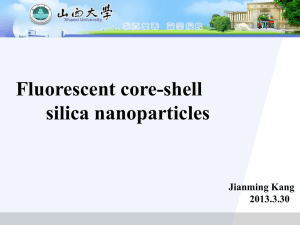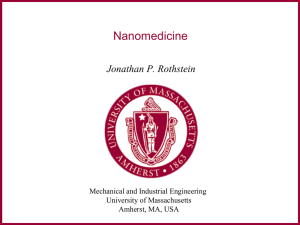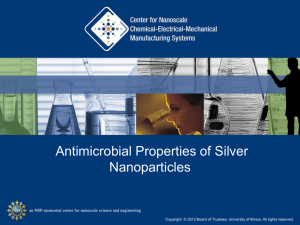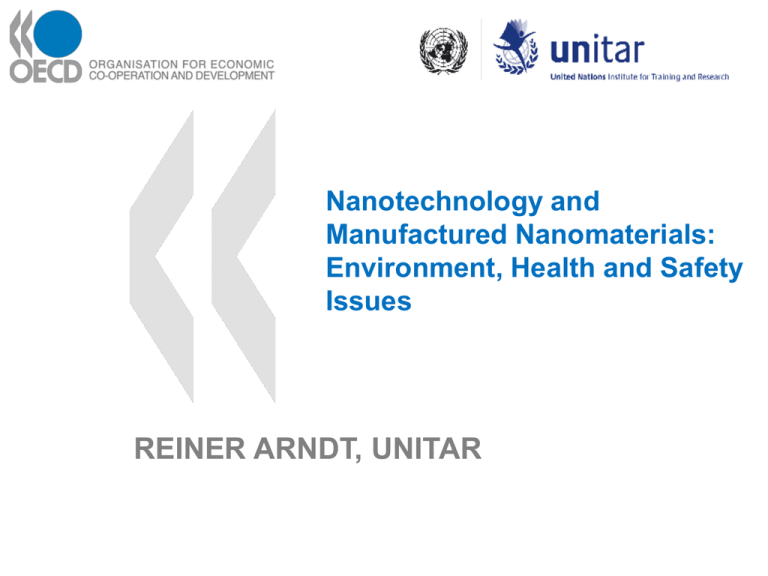
Nanotechnology and
Manufactured Nanomaterials:
Environment, Health and Safety
Issues
REINER ARNDT, UNITAR
Nanometer – World of Atoms and Molecules
1 Nanometer
= 1 part in a billion
12756 km
~10 8m
~ 10-1m
~10-10m
2
Relevance of the issue
• Nanotechnology is an enabling technology that is
expected to result in innovations across many industry
sectors. First products are already on the market
• It is important that all stakeholders concerned engage in
discussions to identify and address policy issues (e.g.
health, environmental, safety, moral, ethical, societal,
legal and social utility concerns)
3
Nanomaterials provide better functionality
Energy
Food,
Cosmetics
Coatings
IT
Applications
Nanotube Elektrode
Military
Construction
Materials
Analytics
Medicine
© 2008 – All rights reserved to THE INNOVATION SOCIETY, St.Gallen / Christoph Meili
4
Manufactured Nanomaterials: Description
• manufactured: intentionally produced versus
unintentionally released (incidental: welding fumes,
diesel soot)
• nanoscale: typically between 1 and 100 nm in at
least one dimension
• new materials and old materials (carbon black) with new
properties
• new chemicals (fullerenes), existing chemicals (TiO2)
• problematic: nanofibers/tubes (nanorods) and
nanoparticles (in two or three dimensions less than
100 nm), aggregates (definition/stability)
• little solubility (in solution loss of nano characteristics)
5
Consumer products (major materials)
Source: www.nanotechproject.org
© 2008 – All rights reserved to THE INNOVATION SOCIETY, St.Gallen / Christoph Meili
6
Exposure to nanoparticles and related hazards
Uptake routes for nanoparticles:
Nanoparticles
Brain
Nose
Lung
Skin GI-Tract
Blood
Brain Bone Marrow Spleen
Wall
Liver
Blood Vessels
Heart
Placenta
Fetus
Degenerative
Changes
7
Nanoparticles: Exposure
Information on Exposure for man and environment:
• Which nanoparticles are released and lead to relevant
direct/indirect exposure (production, use, life cycle) ?
• How to measure relevant parameters (mass
concentration, surface, volume, particle number)?
• How to estimate exposures?
• How to develop an easy and low-cost measurement
technique including personal sampling?
• What is an efficient measurement strategy?
8
Nanoparticles: Hazard and Risk
Information on hazard and risk:
• What effects are induced by nanoparticles for example via
inhalation and dermal contact or in the environment?
• What is/are the relevant effect parameter(s) (mass, surface,
volume, particle number) ?
• Is the effect of nanoparticles comparable to fine dust, but different
in potency ?
• Nanomaterials having specific properties may require a different
classification and labelling compared to the bulk material.
• How to assess agglomerates and aggregates ?
• What is an appropriate test and risk assessment strategy?
9
Problems 1
„Magic Nano“
Bath sealent chemical
> 100 intoxications
(oedema)
Product recall (PennyMarket)
Contained NO
nanoparticles
© 2008 – All rights reserved to THE INNOVATION SOCIETY, St.Gallen / Christoph Meili
10
Problems 2
Skin cream with fullerenes (C60)
Cream with
fullerenes (antiox.)
(30 ml = 266 US$)
Fullerenes were
found to be
neurotoxic in fish
NGOs are calling
for strict regulation
of cosmetics
© 2008 – All rights reserved to THE INNOVATION SOCIETY, St.Gallen / Christoph Meili
11
Problems 3
Nano-Silver washing machine (SAMSUNG)
Antibacterial effect of silver
ions in the washing
machine
Silver lasts for over 3000
wash processes (10 years)
Environmental NGOs are
calling for pest declaration
of silver at the EPA
© 2008 – All rights reserved to THE INNOVATION SOCIETY, St.Gallen / Christoph Meili
12
Nanoparticles: Risk Management
Information on risk management:
• Is the present framework for data generation,
information collection, hazard and risk assessment
sufficient to manage nanoparticles safely?
• Are the present protective measures for fine dust also
effective for nanoparticles ? What else is needed?
• How to develop good working practices while having
insufficient information on effects (precaution)?
• What risk mitigation strategies are already applied?
13
Nanoparticles: Communication
Information on communicaion:
• How to involve all interested parties and stakeholders ?
• How to inform the public about the technical,
economical and social impact of nanotechnology?
• How to inform the user about the uses of nanomaterials,
their benefits, their risks and the uncertainty of the
risks?
14
Responsibilities for Sound management of
chemicals: Nanomaterials
Producer/Exporting Countries
- Generation of information (hazard)
- Risk assessments, Risk management
- Information on classification/labeling C/L, safety
data sheets SDS, risk assessments, risk
management options, bans/restrictions
User/Importing Countries
- Awareness raising (hazard, risk, C/L SDS)
- Make information available
- implement regulatory framework for safe use
- Implementation, Enforcement (resources)
15
National work for SMC of Nanomaterials 1
- Are nanomaterials in my country: where, which uses?
- Are the nanomaterials:
nanoparticles, mixtures of nanoparticles or articles containing
materials with nanostructures
- How can I get this information (survey, notification requirement, nanospecific label) and relevant information on risks?
- What is the type and size of the problem in my country?
- Who in my country is responsible for R&D and who is
responsible for the safety of nanomaterials?
- With whom do I cooperate in my country for SMC(Nano)?
- How to achieve synergies with other SMC activities?
16
National work for SMC of Nanomaterials 2
- How are developed countries addressing the problem of
potential risks of nanoparticles science/regulation?
- What is done on the international level (SAICM, IOMC)?
- What is the present regulatory frame work for industrial
chemicals in my country? Is it sufficient to control the risks
from nanoparticles?
- Is a specific regulatory framework needed for nanoparticles (within SMC or separate) for what problems?
- What voluntary activities are in practice or under
consideration (advisory body, code of practice,
exposure/risk mitigation, nanospecific SDS, ..)?
- How do I raise awareness and involve the stakeholders?
- What do I require from producers or importers?
17
Technical information needs for SMC of Nano
- List of nanomaterials/nanoparticles in international trade
- Main uses of such nanomaterials/nanoparticles, in which
industry branches?
- Possible exposures and health risks/environmental risks:
toxicology, environment effects (new unknown effects or
known effects expected?)
Access to studies and expertise for interpretation
- Monitoring methods and instruments for consumer/worker
and environment exposure
- Proper waste treatment, control transboundary movement
- Code of practice for safe use of worker, consumer and
environment (applying precaution)
18
Benefits of Nanomaterials
Information on benefits of Nanomaterials:
• Proven benefits for the man and/or environment (for
example less toxic, less waste, longer duration, energy
efficient, resource/material efficient, cleaning of
contaminated water, remediation efficient,
environmental sensors)
• Proven sustainability of nano based product compared
to conventional products over the whole life cycle
• Competitive on the market
• Availability, accessibility
19
Thank you!

